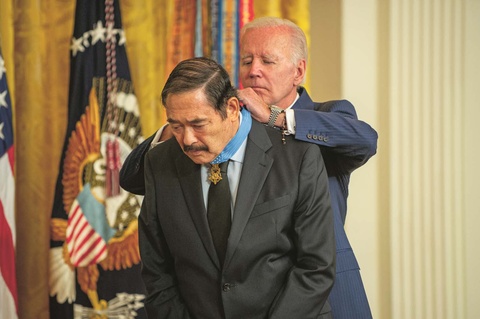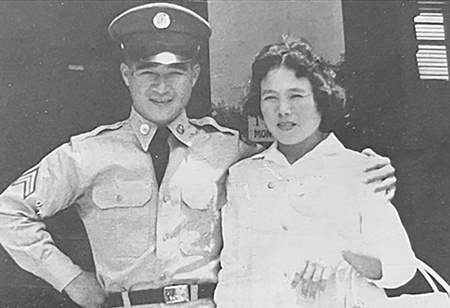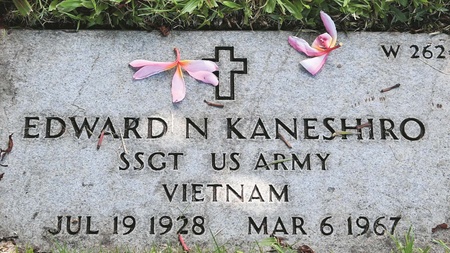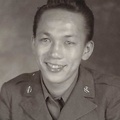
Surrounded and stranded for two days in a forbidden Laotian South Vietnamese firebase, the country’s newest Medal of Honor recipient—Kaua‘i-born Spec. 5 Dennis M. Fujii—described the operation and rescue mission as the scariest he experienced in his nearly three years of combat and believed it would be his last.
Fujii, 74, and Staff Sgt. Edward Noboru Kaneshiro—who also fought in the Vietnam War more than half a century ago—were the latest recipients of the nation’s highest military award for valor—the Medal of Honor. Kaneshiro, who was 38 years old when he was killed in combat on March 6, 1967, three months after he saved his platoon from an ambush, was honored posthumously. The two Sansei veterans will join the 19 other Hawai‘i soldiers—13 of whom were Japanese Americans—who are recipients of the Medal of Honor. Eight of the Hawai‘i Medal of Honor recipients were from the Vietnam War.
President Joseph Biden draped the sky-blue ribbon with the Medal of Honor resting on Fujii’s collar at the White House July 5 ceremony. Kaneshiro’s medal, encased in a wooden box, was presented to his son, John Kaneshiro. Also attending the ceremony were daughter, Naomi Viloria, and son, Tom Kaneshiro—who grew up never knowing their father. Fujii, a Hawai‘i Kai resident, was accompanied to the ceremony by his brother, Edwin.

“Today, we’re setting the record straight,” the president said. “We’re upgrading the awards of four soldiers who performed acts of incredible heroism during the Vietnam conflict to respect the conspicuous gallantry and intrepidity of their service. They went far above and beyond the call of duty. It’s a phrase always used but it just—it takes on life when you see these men.”
Stooped with age and leaning on a cane, Fujii listened while President Biden described “Papa Whiskey,” Fujii’s call sign, as “a clear-eyed, level-headed soldier direct in air strikes so precisely they were able to drive back the forces that had come within 15 to 20 meters (48 to 64 feet) of a friendly camp.” The President said Fujii downplayed his role in saving the South Vietnamese soldiers “simply saying I quote, ‘I like my job. I like to help other people who need help.’”
President Biden added: “It’s amazing.”
It has been a long journey for Fujii, Kaneshiro and two other Vietnam veterans—Maj. John Duffy and Spec. 5 Dwight Birdwell—and their families who were honored at the July 5 ceremony, continued President Biden. “More than 50 years have passed – 50 years,” President Biden said, “since the jungles of Vietnam where as young men, these soldiers first proved their mettle. But time has not diminished their astonishing bravery, their selflessness in putting the lives of others ahead of their own and the gratitude that we, as a nation, owe them.”
The next day Secretary of Defense Lloyd J. Austin III presented the Medal of Honor flag to Fujii, in a ceremony in which Fujii and five other Medal of Honor recipients were inducted into the Pentagon Hall of Heroes, at Joint Base Myer-Henderson Hall, Va.
Both Kaneshiro and Fujii initially had been awarded the Silver Star—the nation’s third highest award for valor—which was later upgraded to the Distinguished Service Cross. Congressional action in December paved the way for Fujii and Kaneshiro’s DSCs to be further upgraded to the Medal of Honor. Their cases have been under review for several years.
President Biden recalled during the 40-minute East Room somber ceremony that the last Medal of Honor ceremony involving Hawai‘i soldiers was in 2000 when six living members of the 100th Infantry Battalion and the 442nd Regimental Combat Team, including one of his “closest friend,” Sen. Dan Inouye, “were recognized for their wartime achievements on the front lawn of the White House.
During a 51-minute conference call on June 27 with reporters from Hawai‘i, Fujii described it as “a great honor for me and I’m sure for everyone else involved.” He said he never expected to be awarded the Medal of Honor because Army officials had told him his actions in Laos involved saving South Vietnamese Rangers and not U.S. soldiers. “I was happy the way things were, and I came home in one piece.”
However, Fujii said the medical evacuation mission was the first time in his nearly three years in combat he “came so close to dying or getting captured. It affected my way of thinking … It was really scary.”
Fujii was born in Hanapēpē on Kaua‘i in 1949. He dropped out of Waimea High School after a disagreement with a teacher during his senior year. He enlisted in the Army in 1968 and was able to get his high school diploma while in the service. He spent his first nine months in South Vietnam assigned to the 2nd Battalion, 35th Infantry, 25th Infantry Division as an assistant machine gunner.
In February 1971, the 21-year-old soldier was on his second Vietnam combat tour as a medevac crew chief with the 237th Medical Detachment, 61st Medical Battalion, 67th Medical Group. He had re-enlisted for his second tour of duty because he wanted to fly and because the enlistment would shorten his Vietnam tour.
The chilling and what Fujii described as a “scary” Feb. 18, 1971, air rescue mission was detailed in a Feb. 4, 2022, Hawai‘i Herald article. Fujii’s “dust off” (Vietnam War call sign requesting medical evacuation helicopter. The call sign refers to the clouds of dust that would be kicked up when the helicopters took off or landed) medevac UH-1 Iroquois Huey helicopter was called to a South Vietnamese Ranger battalion firebase in Laos to evacuate the wounded. His helicopter was attacked from the ground with bullets slamming into the belly of the Huey as soon as it crossed the border into Laos. A South Vietnamese battalion was pinned down in a valley, and North Vietnamese soldiers, sitting on the ridgeline above had zeroed their mortars and artillery on the soldiers. The firebase was littered with the wrecks of helicopters. Fujii’s pilot decided to land, and the crew began to load the screaming wounded South Vietnamese soldiers when a mortar exploded in front of the helicopter and blew out the canopy. Fujii was hit in the shoulder.
A second medevac helicopter was able to land and rescue two pilots and two medics except for Fujii, who had been injured in one eye by another blast and waved off the helicopter coming to rescue him. For the next 17 hours, Fujii, the lone American on the ground, coordinated aerial and airstrikes while administering to wounded South Vietnamese soldiers at times leaving the radio to repel enemy soldiers. Then, after another air ambulance helicopter was finally able to airlift him from the battle, enemy rounds pierced its hull forcing it to crash-land at another friendly South Vietnamese firebase four miles away, where Fujii would be stranded another two days before being evacuated.
Fujii, after the mission, said that he thought he would be court-martialed because President Richard Nixon had promised that no American troops would be on the ground fighting in Laos.
Instead, 10 days later, he was given a hero’s homecoming by Gov. John A. Burns and the key to the county by Kaua‘i Mayor Antone Vindinha. He later transferred to the Hawai‘i Army National and the Pacific Army Reserve but turned down a commission in the Army Reserve. During a news conference on June 28 Fujii said his disabilities prevented him from remaining in the reserves.
Fujii said he has “always wanted to go back to visit (South Vietnam), but I waited too long,” and now he doesn’t think he could make the trip because of health issues. He worked for Hawaiian Telephone Co., a Maui cable television company, and as a utilities and logistics technician on Johnston Atoll before retiring in Honolulu.
Fujii collects disability payments for wounds he suffered when he was shot down. He is now eligible for an additional special tax-free Medal of Honor pension of $1,489.73 per month.
Kaneshiro, a graduate of Leilehua High School, enlisted in the Army on April 2, 1959, four months before Hawai‘i achieved statehood. He had served nearly eight years in the Army when he was sent to Vietnam in July 1966. He was an infantry squad leader with Troop C, 1st Squadron, 9th Cavalry, 1st Cavalry Division during a search and destroy mission of a heavily fortified village at Phu Huu 2, Kim Som Valley 712 miles southwest of Bong Son in the Central Highlands.

He was awarded the Silver Star for his actions on Dec. 1, 1966, when he single-handedly repelled North Vietnamese soldiers who were hiding in a fortified bunker, underground tunnels and trench system that ran the length of the village Phu Huu 2. He is credited in rescuing two pinned down squads after two platoon leaders had been killed. After taking out a machine gun emplacement with a grenade, Kaneshiro advanced 38 yards with just his M-16 rifle and using five more grenades to kill other enemy soldiers. His actions resulted in the orderly regrouping and safe withdrawal of the platoon. His unit recommended that his Silver Star medal be upgraded to the Medal of Honor. Instead, he was given the Distinguished Service Cross.
Kaneshiro was killed in Vietnam three months later after visiting his family in Pearl City and seeing two-and-half month old son, John, for the first time. President Biden told the Kaneshiro family: “I hope today you take some pride and comfort in knowing his valor is finally receiving the full recognition it has always deserved.”
“His [Kaneshiro’s] memory lives on in the lives he saved, in the legend of his fearlessness, and the hearts of the family he left behind,” the president said.
Kaneshiro is buried at the National Cemetery of the Pacific. His widow, wife Mitsuko, who died on April 10 at the age of 90, will be buried next to him on July 22 under the shade of a pink plumeria tree.

“The grief was so profound and growing up it was sort of like an unspoken thing not to mention him because it was so, so tragic for her,” Naomi Viloria, told the Star and Stripes newspaper. She was eight when her father was killed.
My whole body was shaking,” Viloria said when President Biden informed her of the award. “Sometimes I try to imagine what [my dad] went through, like would I be able to do that? It’s very inspiring that he was just fearless or maybe he had fear but did it anyway. That takes a lot of courage, to do that alone. Since he was so humble, I believe in his mind he was just serving his country.”
She also told ABC News their family has worked for decades to have his actions reviewed and nearly gave up. “But then finally, this year, right after my mother passed away, we were notified that his combat record was being under review and he could possibly be awarded the Medal of Honor, and I finally got the call from President Biden,” adding that the family was “overjoyed” to hear the news.
The Army’s Distinguished Service Cross ranks just below the Medal of Honor. The Medal of Honor, which was established in 1861, is awarded to a military member “who distinguished themselves conspicuously by gallantry and intrepidity at the risk of their own lives above and beyond the call of duty….” The Distinguished Service Cross is for deeds of “extraordinary heroism not justifying the award of a Medal of Honor.”
The last time Hawai‘i soldiers were honored by a White House Medal of Honor ceremony was June 21, 2000, during a muggy summer afternoon when Inouye and five other Japanese Americans from Hawai‘i were personally presented with the medal. They were among the 20 Asian Americans—all members of the 100th Battalion or the 442nd Regimental Combat—who had to endure five years of congressional and Pentagon scrutiny before President William Clinton draped the blue ribbon with the distinctive medallion around their necks. President Biden said that the awards were possible because of several congressionally mandated reviews of actions of Native Americans, Asian Americans and Pacific Islanders during World War II, Korean and Vietnam wars who may have been under-recognized.
For Kaneshiro and Fujii, their approval process was surprisingly quick.
Their names were included in the lengthy 2022 National Defense Authorization bill that President Biden signed into law at the end of December last year. The congressional authorization waived time limits in presenting the Medal of Honor because under federal law, recommendations for the Medal of Honor must be submitted within three years of the valorous act, and the Medal must be presented within five years. Any submissions outside this timeline require congressional approval to waive the time limits.
More than 3,500 service members have received the Medal of Honor since its creation in 1862 during the Civil War.
Earlier this year Rep. Ed Case (D-Hawai’i) said he believed the late Rep. Mark Takai, who died in 2016, was one of the proponents who lobbied for a congressional re-examination of the records of Fujii, Kaneshiro, Pvt. Wataru Nakamura, and other Asian Americans. The Army said Nakamura, a WWII veteran of the 442nd Regimental Combat Team, continued his service during the Korean War. The Army said his actions there are still under review.
Sen. Brian Schatz (D-Hawai‘i) said: “Few service members in our nation’s history have shown the courage Staff Sgt. Kaneshiro and Spec. 5 Fujii did while at war, and their heroic actions deserve nothing less than our nation’s highest military decoration.”
Sen. Mazie Hirono (D-Hawai‘i) added: “Service members like Mr. Fujii and Mr. Kaneshiro risk their lives to protect our nation, and we have an obligation to support them following their service.”
*This article was originally published by the Hawai‘i Herald on July 15, 2022.
© 2022 Gregg K. Kakesako / Hawai'i Herald





